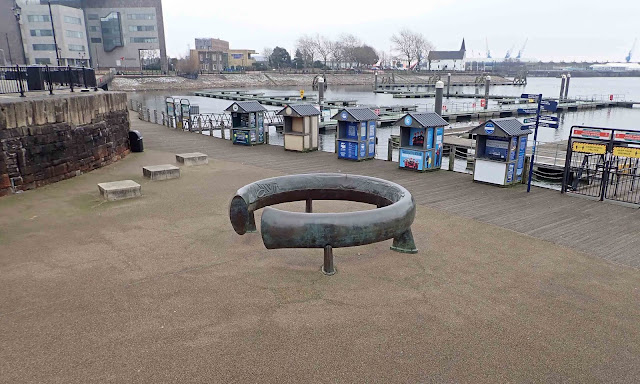My last blog, Under my feet: a key, was an introduction to today’s post on the public artwork that surrounds that ‘key’, which is both a name plate for the artwork and a waymarker to locate the beginning of the Taff Trail.

The Cardiff Bay Development Corporation (CBDC)
was established in 1987 to regenerate the docklands, which had by that time
become a wasteland of disused docks and abandoned buildings. As part of their
regeneration plan, the CBDC commissioned a series of public artworks to complement
the many new building programmes: the Celtic
Ring is one of those commissioned pieces.
It was created by sculptor Harvey Hood in 1993. Though born in Staffordshire and educated both in Birmingham (at the Birmingham College of Art) and London (at the Royal College of Art), Hood has spent much of his adult life in Wales. After completing his MA in London, he moved to the Cardiff College of Art, where he eventually progressed to Head of the Sculpture Department. Though now retired from university teaching, and from his 30 years as director of the Berlanderi Sculpture Workshop near Raglan, Hood continues to create amazing works of sculpture. He has exhibited both nationally and internationally, and his work is held in public and private collections around the world.
On Harvey Hood’s personal website there is an excellent blog post that documents, using many fascinating images, the process involved in the creation of the Celtic Ring. It moves from Hood’s sketching his initial ideas on the shores of the Bay before the Barrage was built, to the intriguing process of manufacturing the artwork, from clay mould to plaster cast to fibreglass to bronze.
As you can see from my photos of the Ring’s interior, its surface is textured with many features relating to the maritime and industrial environment in which it is located. As well as references to local landmarks like the Norwegian Church, the former Hamadryad Hospital ship, and several of the local docks, there are seafaring instruments and tidal charts. It is a remarkable artwork that has stood well the test of time since its creation almost thirty years ago.







No comments:
Post a Comment